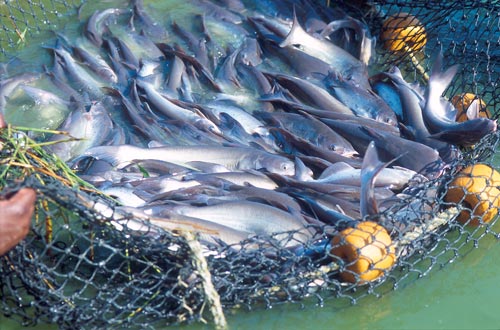
Supplies of U.S. pond-raised catfish are down significantly, as producers have cut back on production due to increases in feed costs brought on by higher corn and soybean prices.Catfish water acres have generally declined since the 2008 spike in commodity prices, and according to USDA, have dropped 39 percent from last year. Meanwhile, catfish feed prices have increased 53 percent since 2007.Outside the South, restaurants have started to rely on cheaper imports to fill demand for low-end priced catfish. In the South, there appears to be a preference for home-grown catfish, which apparently has slowed imports into the region.

In Cleveland, Miss., a popular restaurant specializing in catfish takes the prized southern delicacy off its all-you-can-eat buffet and puts it on the regular menu only. Another Mid-South restaurant keeps it on the buffet, but raises the buffet price by a dollar per person.
Across the Mid-South, people are starting to ask the question – “Just how short are catfish supplies?”
According to John Michael Riley, a commodity marketing specialist for the Mississippi State University Cooperative Extension Service, supplies of U.S. pond-raised catfish are indeed down significantly, as producers have cut back on production due to increases in feed costs brought on by higher corn and soybean prices.
Catfish water acres have generally declined since the 2008 spike in commodity prices, and according to USDA, have dropped 39 percent from last year. Meanwhile, catfish feed prices have increased 53 percent since 2007.
As a result of less production this year, catfish processing declined 32 percent from last year, which is why catfish prices are moving higher. According to Auburn and MSU studies, wholesale catfish fillet prices have increased by 36 percent and 34 percent for fresh and frozen catfish, respectively, since 2007.
“It’s almost transitioned from the ball being in the processors court to the ball being in the grower’s court,” Riley said. “If you look at the price the grower receives for catfish, it was a straight line for so long. Over the latter part of 2010 and into the first and second quarter of 2011, we started to see that price start to bump up each month.
“The processor is going to pass that (increase in price) through to retail, whether that is a restaurant or a grocery store. Restaurants are having to increase menu prices. In some cases, they may take catfish off the buffet table and keep it on the menu. On the buffet line, they’re not able to extract the premiums they’re having to pay.”
According to the article South Sings Catfish Blues, in the Wall Street Journal online edition, some restaurants are now paying as much as dollar a pound more for catfish.
Outside the South, restaurants have started to rely on cheaper imports to fill demand for low-end priced catfish, Riley said. Imports of catfish cousins of the order siluriformes for June 2011 totaled 14.6 million pounds, up 42 percent from June 2010. The imports are from Cambodia, China, Mexico, Spain, Thailand and Vietnam.
In the South, there appears to be a preference for home-grown catfish, which apparently has slowed imports into the region.
“Even though we’re in a situation of much lower production and higher prices, we’re finding great support out there from our customers, who are telling their restaurants they prefer home-grown catfish and are prepared to pay a higher price for it,” said Mike McCall, editor of the Catfish Journal, the catfish industry’s trade publication. “That’s encouraging to us, and hopefully we can grow some more fish and serve their needs.”
“Catfish demand is a lot stronger in the South and Southeast versus other parts of the nation,” Riley said. “The southern culture is very tied to anything home-grown. We’re going to continue to see home-grown catfish in the South unless it gets too exorbitantly priced.”
McCall said there’s no question that catfish producers are doing better financially at current prices, but he doesn’t think many will expand water acres substantially next year. “Our feed prices are still way up there, with little chance of them coming back down.
“Plus, it would be an expensive venture to go back in and rework those ponds, stock them, and grow fish. It would take you almost two years to do it. You’re not going to see a real rush to do that because the cost is so high. A few acres may be brought back in, but not a whole lot.”
While it was feared that spring flooding may also have reduced catfish stocks by allowing catfish to escape the confines of ponds, anticipated breaching by floodwater did not occur to a great extent.
McCall said there were some isolated cases where ponds were breached by floodwaters in the south Delta. “Those ponds are being reworked and cleaned out. Fortunately, the farmers realized there was a good chance the ponds would be flooded, so they got most of the fish out and moved them.”
About the Author(s)
You May Also Like





